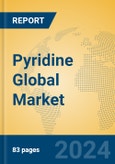Pyridine is a versatile heterocyclic compound used in pharmaceuticals, agriculture (notably agrochemicals), nutritional products, oilfield chemicals, and other applications. As a key building block in agrochemicals - especially fourth-generation pesticides like chloropyridine herbicides - it offers low toxicity and high efficacy, driving significant market demand. With over 70 pyridine-containing pesticides, including mainstream products like imidacloprid and emerging ones like flonicamid, it dominates agrochemical use. The industry is a vital segment of the global specialty chemicals market, characterized by its chemical reactivity, broad therapeutic applications (e.g., antiviral, oncology), and role in custom synthesis for CDMO opportunities. The market is driven by agrochemical demand, pharmaceutical innovation, and nutritional growth, particularly in emerging economies. However, it faces challenges from regulatory restrictions, competition from substitutes, and raw material volatility, shaping its growth trajectory.
CDMO opportunities in pharma drive growth.
Nutritional segment growth enhances market potential.
Competition from substitutes challenges market share.
Raw material volatility affects production costs.
This product will be delivered within 1-3 business days.
Market Size and Growth Forecast
The global Pyridine market is estimated at approximately USD 380 to 480 million in 2025, with a projected compound annual growth rate (CAGR) of 3.2% to 4.8% from 2025 to 2030, reaching USD 450 to 610 million by 2030. This growth reflects steady agrochemical and pharma demand, supported by innovation, though moderated by regulatory and cost factors.Regional Analysis
- North America: Holding 20-25% of the market share, North America grows at 2-3%. The United States leads with demand in pharmaceuticals and nutrition, though trends note declining pyridine production (e.g., Aurorium closure in 2023).
- Europe: Accounting for 15-20% of the market share, Europe grows at 1.5-2.5%. Germany and the UK emphasize pharmaceuticals, with trends focusing on regulatory compliance and reduced pesticide use.
- Asia Pacific: Representing 45-50% of the market share, this region grows at 4.5-6%. China and India dominate due to agrochemical and pharma growth, with trends emphasizing cost-effective production and CDMO opportunities.
- Rest of the World: With a 10-15% share, this region grows at 3-4%. Brazil and South Africa see uptake in agriculture, driven by pesticide demand. Trends focus on affordable solutions.
Application Analysis
- Pharmaceutical: Expected to grow at 3.5-4.5%, used in drug synthesis. Trends focus on therapeutic diversity.
- Agricultural: Projected at 3-5%, dominant application. Trends emphasize fourth-generation pesticides.
- Nutritional: Anticipated at 4-6%, growing use in vitamins (e.g., B3). Trends target feed and nutraceutical growth.
- Oilfield Chemicals: Expected to grow at 2.5-3.5%, niche use. Trends focus on chemical additives.
- Others: Projected at 2-3%, covering minor uses. Trends explore industrial applications.
Key Market Players
- Jubilant Ingrevia Limited: A global leader in pyridine production (>50,000 tons capacity).
- Resonance Specialties Limited: Specializes in pyridine derivatives.
- Nanjing Red Sun: Major producer with large capacity (>50,000 tons).
- Shandong Luba Chemical: Offers pyridine for agrochemicals.
- Koei Chemical: Focuses on high-quality pyridine products.
Porter's Five Forces Analysis
- Threat of New Entrants: Medium; high capital and regulatory barriers deter entry, though demand offers opportunities.
- Threat of Substitutes: Medium; alternative chemicals compete, but pyridine’s versatility sustains demand.
- Bargaining Power of Buyers: High; agrochemical and pharma firms negotiate pricing.
- Bargaining Power of Suppliers: Medium; reliance on raw materials gives leverage, offset by sourcing diversity.
- Competitive Rivalry: High; players compete on cost, capacity, and innovation.
- Supply Chain Localization Impact: Tariff conflicts encourage localized production in North America and Europe, reducing Asian reliance (e.g., China), enhancing stability, though raising costs after closures like Aurorium’s.
Market Opportunities and Challenges
Opportunities:
Agrochemical demand in Asia Pacific boosts pyridine use.CDMO opportunities in pharma drive growth.
Nutritional segment growth enhances market potential.
Challenges:
Regulatory restrictions on pesticides limit applications.Competition from substitutes challenges market share.
Raw material volatility affects production costs.
This product will be delivered within 1-3 business days.
Table of Contents
Chapter 1 Executive SummaryChapter 2 Abbreviation and Acronyms
Chapter 3 Preface
Chapter 4 Market Landscape
Chapter 5 Market Trend Analysis
Chapter 6 Industry Chain Analysis
Chapter 7 Latest Market Dynamics
Chapter 8 Trading Analysis
Chapter 9 Historical and Forecast Pyridine Market in North America (2020-2030)
Chapter 10 Historical and Forecast Pyridine Market in South America (2020-2030)
Chapter 11 Historical and Forecast Pyridine Market in Asia & Pacific (2020-2030)
Chapter 12 Historical and Forecast Pyridine Market in Europe (2020-2030)
Chapter 13 Historical and Forecast Pyridine Market in MEA (2020-2030)
Chapter 14 Summary For Global Pyridine Market (2020-2025)
Chapter 15 Global Pyridine Market Forecast (2025-2030)
Chapter 16 Analysis of Global Key Vendors
List of Tables and Figures
Companies Mentioned
- Jubilant Ingrevia Limited
- Resonance Specialties Limited
- Nanjing Red Sun
- Shandong Luba Chemical
- Shandong Minghua New Materials Co. Ltd
- Koei Chemical








